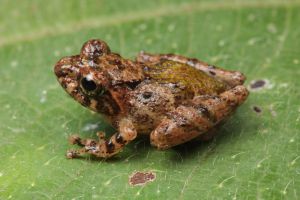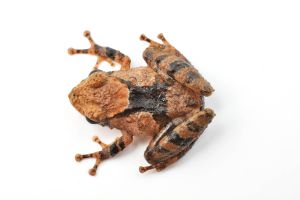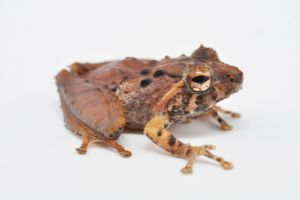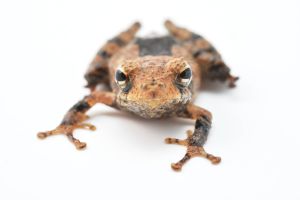
Frogs of Borneo

Frogs of Borneo

Frogs of Borneo

Frogs of Borneo

Frogs of Borneo

Frogs of Borneo

Frogs of Borneo

Frogs of Borneo

Frogs of Borneo

Frogs of Borneo

Frogs of Borneo
Bornean Families
Philautus:
refugii
Western Lowland Bush Frog
Philautus refugii was described by Inger and Stuebing (1996), with the type locality given as “Bukit Lanjak, 840 m, Lubok Antu District, Second Division, Sarawak, Malaysia.” Records are currently known only from Sarawak, but the species may prove to be more widespread.
Inger and Stuebing (1996) provided the following diagnosis for the species: “Cutaneous pectoris muscle present; lingual papilla absent; male with round nuptial pad; female with small rostral cone; fifth toe webbed to distal edge of distal subarticular tubercle or beyond; anterior face of thigh with conspicuously barred pattern; rear of thigh reddish brown; males <19 mm, females <21 mm.” The snout is obtusely pointed and not projecting in males; in females, the snout bears a small, projecting rostral cone. The canthus rostralis is rounded. A supratympanic fold is present, relatively straight, and often not very distinct. The eardrum is visible but rather indistinct. All digits bear terminal adhesive discs. The underside is coarsely granular. Moderately long tubercles occur on top of the head and eyelids, on the shoulders, and along the mandible and outer tarsus.
Coloration ranges from medium to dark brown, often with an H- or X-shaped pattern on the back. The anterior face of the thigh is whitish with narrow brown bars or brown with large whitish spots. The throat is heavily marked with brown; the belly bears scattered small brown dots. The limbs show dark crossbars. The iris is pale bronze with brown or reddish-brown anterior and posterior sectors.
The species is similar to Philautus davidlabangi and P. juliandringi. These two species lack the barred pattern on the anterior face of the thigh. Philautus refugii has a rounder snout and canthus (more pointed and edged in the other two) and is smaller overall, with the head and body appearing more compact than in P. davidlabangi and P. juliandringi. A heel tubercle is present in P. refugii but absent in P. juliandringi. Interestingly, the trunk section of the body appears somewhat small in proportion to the hind limbs and head in P. refugii.
Very little is known about this tiny brown Philautus. According to our own observations, it inhabits fern thickets at forest edges or in small clearings. Due to its small size, it is difficult to detect visually; its presence is more easily recognized by its call. The reproductive mode of this species remains unknown. Inger and Stuebing found only two to three eggs in captured females, indicating a small clutch size.
Version tracking
-
29.10.2025
updated







